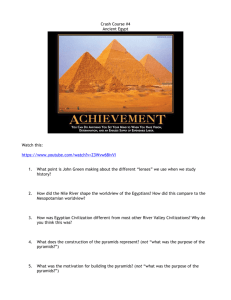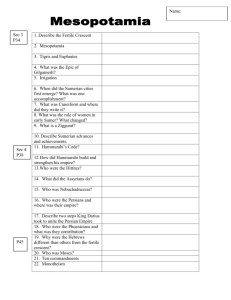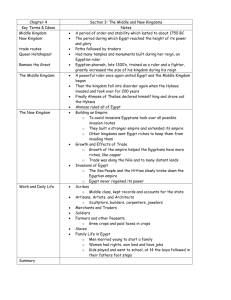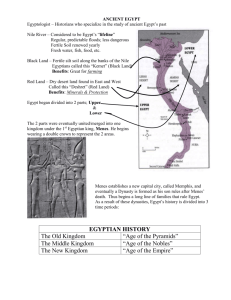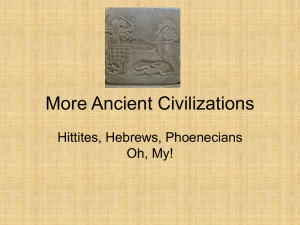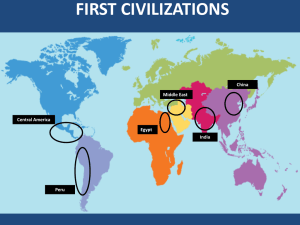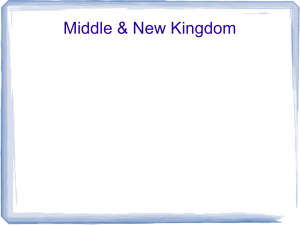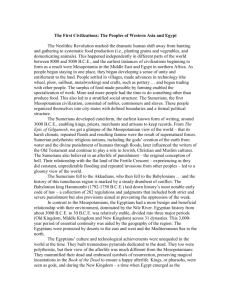Topic: How did the achievements of the Old Kingdom mark it as a
advertisement
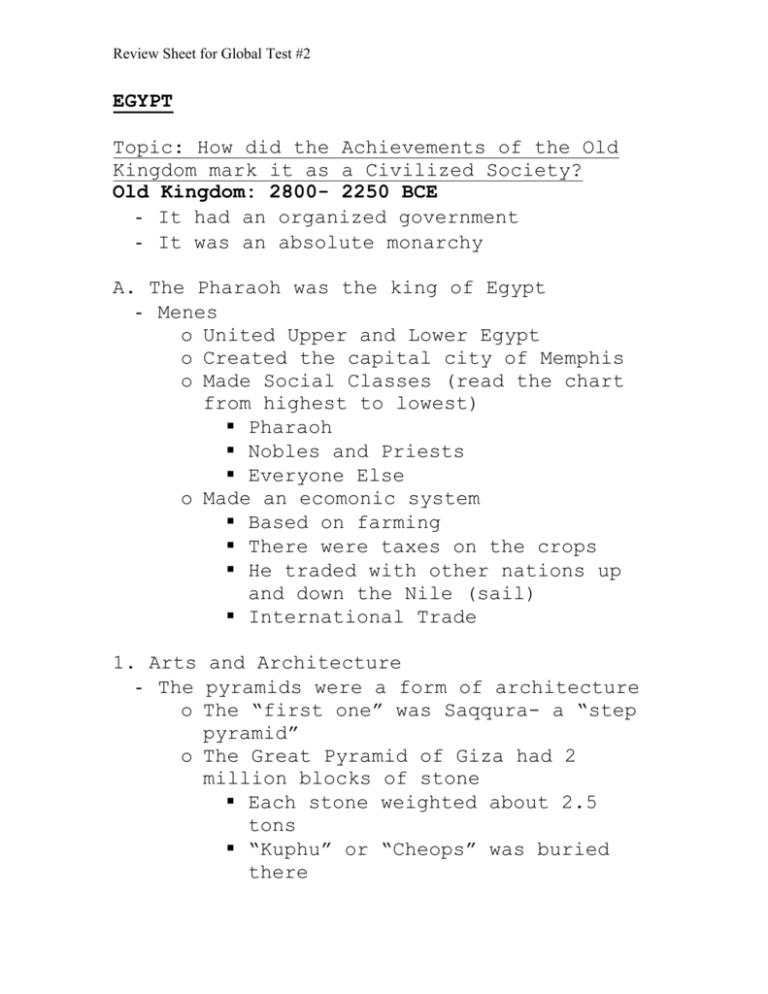
Review Sheet for Global Test #2 EGYPT Topic: How did the Achievements of the Old Kingdom mark it as a Civilized Society? Old Kingdom: 2800- 2250 BCE - It had an organized government - It was an absolute monarchy A. The Pharaoh was the king of Egypt - Menes o United Upper and Lower Egypt o Created the capital city of Memphis o Made Social Classes (read the chart from highest to lowest) Pharaoh Nobles and Priests Everyone Else o Made an ecomonic system Based on farming There were taxes on the crops He traded with other nations up and down the Nile (sail) International Trade 1. Arts and Architecture - The pyramids were a form of architecture o The “first one” was Saqqura- a “step pyramid” o The Great Pyramid of Giza had 2 million blocks of stone Each stone weighted about 2.5 tons “Kuphu” or “Cheops” was buried there Review Sheet for Global Test #2 Largest of the pyramids - Post and Lintels- like a door2. Science - Calendar o Used for planting o Solar- 365 days/year - Number system based on 10 1-10 - Book of Healing Diseases- exactly what the title is 3. Complex Religion - Afterlife and Mummification Topic: How did Egypt Change After the Old Kingdom? - End of the Old Kingdom o The nobles became stronger o The pharaohs became weaker o A civil war erupted - Middle Kingdom o Made by a strong pharaoh o The same thing happened with the old kingdom (civil war) o Amount of farm land increased o Conquered Newbia which went back and forth o Trade continued - Hyksos invaded and conquered all of Egypt - Egypt was in a period of weakness - New weapons: horse drawn chariots, compound bow Review Sheet for Global Test #2 New Kingdom: 1150- 650 BCE 4. New Kingdom= the empire period - Empire= includes more than one group of people - Kingdom= one culture and kingdom - No more pyramids rather cliff-side tombs 1. Hatshepsut - Female - Peace- encourage trade - Wore fake beard like all pharaohs - Financially successful - Expedition to Punt - Builder 2. Thutmost 3 (her nephew and her step- son) - Chiseled Hatsheput's name out of everything - Other wise known as the "Napoleon of Egypt" - He built the empire - Boastful pharaoh- his achievements were engraved on monuments- about battles 3. Amunhotep 4 - Didn’t like his name o Switched his name to Akhenton - Mono-theist towards the sun - Reformist - Built the capital of Amarna o There was an Artistic Revolution- to have more realism 4. Tutankhaton Review Sheet for Global Test #2 Changed his name to Tutankamun Other wise known as King Tut The Artistic Revolution was over Thieves was the new capital He had the only ancient tomb that waas in tact - Minor pharaoh but impressive tomb 5. Ramses 2 - Pharaoh of the Torah - Conqueror MESOPOTAMIA - SUMER Topic: Why was Sumer Considered a Civilized Area? - Sumer was possibly older than the Old Kingdom 1. Geography of Mesopotamia - Part of the “Fertile Crescent”— a crescent- shaped land in the Middle East in which the soil is rich and good for planting - It’s between the Tigris and Euphrates rivers - There was a flood problem, unlike Egypt o The flood happened whenever o It washed away the great soil o However, it helped develop a government because it made people work together to drain Review Sheet for Global Test #2 the flood. They then need a head to tell them what to do and that formed a government 2. Sumer - City- States o Almost like there own country but part of Sumer as a whole. There was a city- state called Sumer though o They were able to go to war o Same size as a city o Each city- state had their own customs and their own way of life o They tended to fight against eachother o Everyone had their own was of life o There was more local control o They were more vulnerable to outside conquerors - Writing o Cuneiform - They drew lines and triangles in clay tablets o Behistun Rock - Had the same thing in three different languages - Compared to the Rosetta Stone - Three Languages: Old Persian, Elamite, and Babylonian - Rawlinson deciphered the rock Review Sheet for Global Test #2 - Arts and Architecture o Arch and Dome o Ziggurats - A form of a temple - Used in all city- states - Differentiated between which “god” the city- states worshipped - Other Achievements o First wheeled vehicles o Created a number system based on 60 o Basic algebra and geometry - Social Classes (Scale from Highest Class to Lowest Class) 1st. Rulers, officials, high priests, and nobles 2nd. Artisans (craftsmen), merchants, lower level priests, and scribes 3rd. Peasants- farmersthey had to pay taxes ( most people were peasants) 4th. Slaves Topic: How did a Succession of Empires shape Mesopotamia? - There was a succession of people of conquered Mesopotamia and then they were conquered - How does an empire differ from a kingdom? o Empire- different cultures Review Sheet for Global Test #2 o Kingdom- one culture - Sargon of Akkad conquered the Sumerian city- states and started the Akkadian empire - Then came the Babylonians who conquered the Akkadians and they conquered the area o Hamurabi - Hammurabi’s Code- He gathered customary rules into written codes. He wrote them down so people wont forget them and so the judges don’t change the law. Example of a law: “An eye for an eye.” We have this in Judiasm, except in Judiasm we pay the value of the eye. Rather in Babylonian times, they really did knock out the other person’s eye for an eye. This was info only the victim was a free man. If he was a slave, you pay the owner half of what the cost would be
